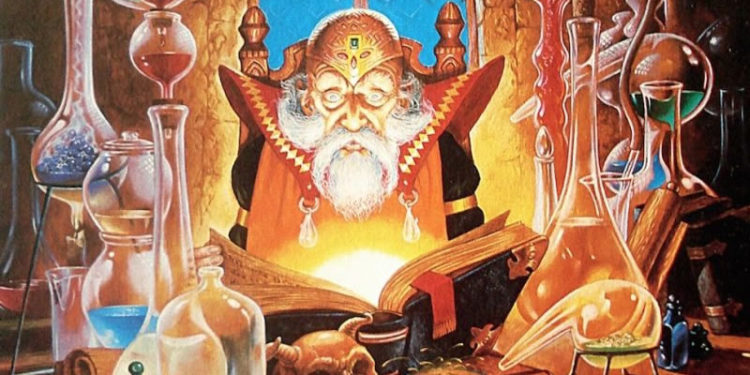Residuum and D&D 5th Edition – Enchanting and Disenchanting Magic Items

Oil, water, gems and metals are some of the most precious resources in our world – creating immense wealth for those who possess them. Crimes are committed, the environment is destroyed and even wars are fought to attain these resources at all costs. In most of D&D’s fantasy settings, magic is the most important resource allowing those who possess the ability to control it to gain power, wealth and even the ability to conquer death. In some worlds, magical items can be converted into an immensely valuable magical powder called residuum. The powder can be traded as a commodity and used to enchant magical items.
residuum[ri-zij-oo-uh m]: the residue, remainder, or rest of something.
In my current campaign set in the Nentir Vale (D&Ds 4th edition default setting), I thought about introducing residuum – since it was used in 4th edition.Residuum can be a good or terrible thing to introduce to your game.
GOOD: It gives your players a way to take unwanted magical items and turn them into something they want during downtime.
BAD: It gives your players a way to take a bunch of common magical items you were fine with having in your game and turning them into potentially a more powerful game breaking magic item you didn’t plan for.
I ended up not adding the rules, since I decided to just handle magical items using the default 5th edition rules/suggestions. Here are my notes on residuum…
Ideas for Adding Residuum into your Game
- Residuum is the byproduct left over when magical items are disenchanted
- There’s a sidebar in the D&D 4th Edition PHB (p 225) that specifies residuum as being a golden or silvery powder, with 10,000 gp worth being just larger than a gold piece itself. A pound is called out as having a value around 500k gp.
- Residuum could also be extracted from astral diamonds (essentially crystallized residuum) and produced from the bones of magical beings.
- When upgrading a magic item, it should be up to the DM how close in the form the new upgrade needs to match the previous magic item.
- It might be a good idea to only allow for upgrading magic item versus creating new magic items using the ritual.
- If you want to put some risk in the ritual, you could add a d100 chance of failure and being left with nothing for higher level magic items.
- I have even heard of residuum being used by DMs as:
- a narcotic a person could inhale/ingest to get a type of magical high
- a way to boost spellcasting (or other abilities) temporarily
My Homebrew Residuum Rituals
Here are a couple of rough first draft rituals to use residuum to enchant and disenchant magical items in your 5th edition game roughly converted from 4th edition. I think it’s a good idea to require certain caster levels to be required to enchant/disenchant powerful items. In 4th edition, magic items matched up with player levels from 1-30, so you that made matching items to level simple. for 5e, I matched up magic item rarity with the caster level for wizards of the level found on p.113 of the DMG with some adjustments up.
Enchant Magic Item
3rd-level transmutation (ritual)
Casting Time: 1 to 8 hours
Range: Touch
Components: V, S, M (residuum and/or coins)
Duration: Instantaneous
Magic drawn from the warp and weft of the universe infuses the item you hold in your hands. Casting this ritual allows you to create a magic item or upgrade an existing magic item using a quantity of gold or residuum equal to the cost of the magic item. To create a magical item, the component cost is the price of magical item. For an existing magical item that your are magically upgrading, the component cost is the difference in price between the existing item and the upgraded magical item.
A magic item can only be enchanted by magic users with a spell casting level that matches the rarity of the magic item according to the table below.
| Rarity | Spell Casting Level | Casting Time |
|---|---|---|
| Common or Uncommon | 3rd Level or Higher | 1 Hour |
| Rare | 5th Level or Higher | 2 Hours |
| Very Rare | 7th Level or Higher | 4 Hours |
| Legendary | 9th Level | 8 Hours |
Disenchant Magic Item
3rd-level transmutation (ritual)
Casting Time: 1 to 8 hours
Range: Touch
Components: V, S
Duration: Instantaneous
Casting this ritual allows you to turn a magic item into residuum. When you touch an item after casting this ritual, you destroy it. The magic item ignites in a brief flash of brilliant light, then crumbles to silvery or golden dust in your hands, turning it into a quantity of residuum valued at 1/5 of the item’s price.
A magic item can only be disenchanted by magic users with a spell casting level that matches the rarity of the magic item according to the table below.
| Rarity | Spell Casting Level | Casting Time |
|---|---|---|
| Common or Uncommon | 3rd Level or Higher | 1 Hour |
| Rare | 5th Level or Higher | 2 Hours |
| Very Rare | 7th Level or Higher | 4 Hours |
| Legendary | 9th Level | 8 Hours |
Let me know what you think or residuum and if you have used it in your game before.
If you want some more ideas on D&D’s magic economy, check out Tribality author Brandes Stoddard’s thoughts in an article on his personal blog looking at this subject:
D&D 5e: Magic Item Economy



